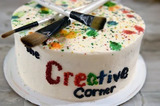
Learn why artists have been featuring food as a subject in their work for centuries. You’ve been told to eat your vegetables, but have you ever tried to paint them? Special Guest Lisa McLaughlin, the baker behind Jesse’s Girl Cookies, invites us into her kitchen to experiment with modern art techniques on cakes, and then we’ll make our own painting of a scrumptious treat inspired by 20th-Century painter Wayne Thiebaud.
- Subject:
- Career Connections
- STEM/STEAM
- Visual Art
- Material Type:
- Activity/Lab
- Lesson
- Visual Media
- Author:
- Trish Reed
- Date Added:
- 05/27/2021
